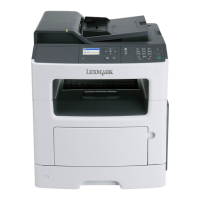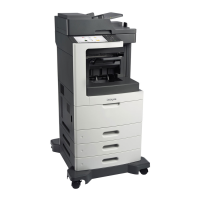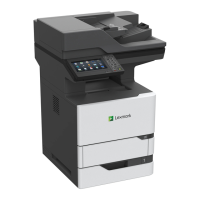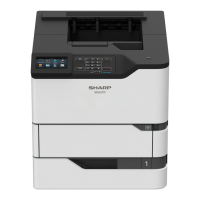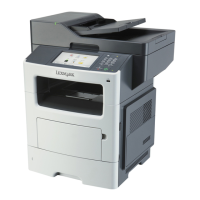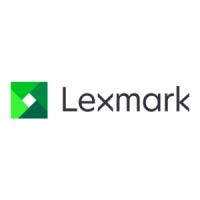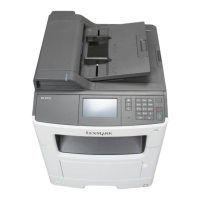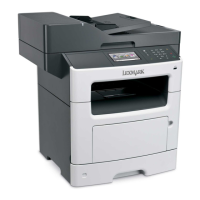Understanding printer menus Page: 98 Menus list Provides an overview of the main menu categories available on the printer.
Paper Menu Accesses settings related to paper handling, including default source, size, and type.
Reports Menu Allows printing of various reports detailing printer status, statistics, and settings.
Network;Ports menu Provides access to network configuration settings, including NIC and port options.
Security menu Contains options for managing printer security, such as audit logs and passwords.
Settings menu Contains general printer settings, including display language, eco-mode, and ADF beep options.
Help menu Provides access to built-in help resources and information about printer features.
Manage Shortcuts Allows management of shortcuts for fax, e-mail, and FTP functions.
Paper menu Covers settings related to paper handling, including default source, size, type, and tray linking.
Configure MP menu Determines how the printer selects paper from the multipurpose feeder.
Paper Texture menu Lets users specify the relative texture of loaded paper for optimal print quality.
Paper Weight menu Allows specification of the relative weight of different paper types for proper feeding.
Custom Types menu Allows association of paper types with custom names for easier selection.
Reports menu Provides options to print various reports, including menu settings, device statistics, and network information.
Network;Ports menu Accesses network interface settings, including active NIC and standard/network port configurations.
TCP;IP menu Covers TCP/IP settings such as hostname, IP address, netmask, and DHCP configuration.
IPv6 menu Configures IPv6 network settings for the printer.
Wireless menu Contains settings for establishing and securing a wireless network connection, including WPS.
AppleTalk menu Enables and configures AppleTalk support for network connectivity.
SMTP Setup menu Configures settings for sending e-mails via SMTP server, including gateway and security options.
Security menu Provides access to security features like audit logs and user authentication.
Settings menu Provides access to general settings like display language, supply estimates, eco-mode, and ADF beep.
General Settings menu Contains options for display language, supply estimates, eco-mode, and ADF beep settings.
Paper Sizes Specifies the unit of measurement for paper sizes.
Alarms Configures audible alarms for printer status and cartridge conditions.
Timeouts Sets timeouts for Sleep mode and Hibernate mode to manage power consumption.
Timeouts Manages timeouts for screen display, print jobs, and wait times before job cancellation.
Error Recovery Configures automatic printer reboots and recovery from errors.
Print Recovery Manages how the printer recovers from situations like offline status or jammed pages.
Print Recovery Controls printer behavior regarding jammed paper and page protection.
Factory Defaults Allows resetting printer settings to their original factory defaults.
Copy Settings menu Contains options for customizing copy jobs, including content type, source, duplexing, paper saver, and collation.
Original Size Specifies the paper size of the original document for copying.
Separator Sheets Manages the insertion of separator sheets between pages, copies, or jobs.
Darkness Adjusts the lightness or darkness of copies.
Overlay Specifies overlay text to be printed on each copy page.
Auto Center Automatically aligns content at the center of the page.
Contrast Adjusts the contrast for copy jobs.
Mirror Image Creates a mirror image of the original document.
Fax Settings menu Contains options for configuring fax mode, memory use, caller ID, and fax number masking.
Fax Send Settings Manages settings for sending faxes, including resolution and original document size.
Content Type Specifies the type of the original document for faxing.
Content Source Identifies how the original document was produced for faxing.
Dial Prefix Allows setting a dialing prefix for fax transmissions.
Redial frequency Sets the interval between automatic redial attempts for fax jobs.
Enable ECM Enables or disables Error Correction Mode for fax jobs.
Dial Mode Specifies the dialing sound mode (tone or pulse).
Max Speed Sets the maximum baud rate for sending and receiving faxes.
Contrast Specifies the contrast in scanned images.
Sharpness Adjusts the sharpness of scanned images.
Fax Receive Settings Configures settings related to receiving faxes, including enabling reception and job waiting.
Paper Source Specifies the paper source for printing incoming fax jobs.
Fax Footer Prints transmission information at the bottom of received faxes.
Max Speed Sets the maximum speed for receiving faxes.
Fax Forwarding Enables forwarding of received faxes to other recipients.
Forward to Specifies the recipient type for fax forwarding.
Fax Log Settings Configures printing of transmission and error logs for fax jobs.
Logs Display Controls whether logs display dialed numbers or fax names.
Speaker Settings Configures speaker modes, volume, and ringer volume for fax operations.
Answer On Sets ring patterns for the printer to answer incoming calls.
E-mail Settings menu Configures settings for sending scanned documents via e-mail, including server setup, format, and content type.
Resolution Sets the scan resolution in dots per inch for scanned documents.
Orientation Specifies the orientation of the scanned image for scans.
Sides (Duplex) Informs the printer about the document's duplex (two-sided) or simplex (one-sided) nature.
JPEG Quality Adjusts the quality of JPEG images in relation to file size for scans.
Text Default Sets the quality of text images in relation to file size for scans.
Text;Photo Default Sets the quality of mixed text/photo images in relation to file size for scans.
Photo Default Sets the quality of photo images in relation to file size for scans.
Use Multi-Page TIFF Provides a choice between single-page and multiple-page TIFF files for scans.
Contrast Specifies the contrast of scanned output.
Sharpness Adjusts the sharpness of scanned images.
FTP Settings menu Configures settings for sending files via FTP, including format, version, content type, and security.
Content Source Specifies how the original document was produced for FTP sending.
Resolution Sets the scan resolution in dots per inch for FTP transfers.
Orientation Specifies the orientation of the scanned image for FTP transfers.
Original Size Sets the paper size of the original document for FTP transfers.
Sides (Duplex) Specifies the page orientation for text and graphics in FTP scans.
JPEG Quality Adjusts the quality of JPEG images in relation to file size for FTP transfers.
Text Default Sets text image quality in relation to file size for FTP transfers.
Text;Photo Default Sets mixed text/photo image quality in relation to file size for FTP transfers.
Photo Default Sets photo image quality in relation to file size for FTP transfers.
Use Multi-Page TIFF Provides a choice between single-page and multiple-page TIFF files for FTP scans.
Print Settings Configures printer settings like language, print area, and resource save options.
Setup menu Contains sub-menus for printer language, print area, and resource save settings.
Resource Save Manages temporary downloads like fonts and macros to optimize memory usage.
Finishing menu Controls print finishing options such as duplexing, binding, copies, blank pages, and collation.
Separator Sheets Manages the insertion of separator sheets between pages or jobs.
Paper Saver Allows printing multiple pages on a single sheet of paper.
Quality menu Contains settings to optimize print quality, including resolution, pixel boost, toner darkness, and gray correction.
XPS menu Manages settings related to XPS print jobs, such as error page printing.
PDF menu Configures PDF specific settings like scaling and annotations.
PCL Emul menu Contains settings for PCL emulation, including font source, name, symbol set, and point size.
PCL Emulation Settings Configures PCL emulation parameters like pitch, orientation, lines per page, and auto CR/LF.
Tray Renumber Allows renumbering of trays and feeders, viewing defaults, and restoring assignments.
HTML menu Configures settings for HTML document printing, including font name, size, scale, orientation, and margins.
Image menu Manages image settings for printing, such as auto fit, invert, scaling, and orientation.
Help menu Provides access to built-in help resources and information about printer features.
Troubleshooting Page: 182 Fax memory full Explains how to clear the message when the printer's fax memory is full.
Memory full [38] Alerts about full printer memory, suggesting job cancellation or memory upgrade.
Tray problems Guides users through troubleshooting issues related to printer trays, including jams and recognition problems.
Paper feed problems Addresses issues related to paper feeding, including pages not being reprinted and frequent jams.
Paper curl Provides steps to resolve paper curling issues by adjusting guides and checking paper settings.
Print irregularities Continues addressing general print irregularities, focusing on paper texture and settings.
Print is too dark Offers solutions for printouts that are too dark, including adjusting toner and paper settings.
Print is too light Provides steps to resolve printouts that are too light, including adjusting toner darkness.
Skewed print Provides steps to resolve skewed print output by adjusting guides and checking paper.
Skewed print Continues troubleshooting skewed prints by checking paper support and settings.
Toner rubs off Addresses toner rubbing off prints, often related to paper type or imaging unit issues.
Solving copy problems Covers troubleshooting for various copy issues, including unresponsiveness and quality.
Poor copy quality Addresses common issues related to poor copy quality, including check messages, document quality, and settings.
Solving fax problems Covers troubleshooting for various fax issues, including setup, connectivity, and quality.
Caller ID is not shown Addresses issues where caller ID information is not displayed, suggesting checking telephone company service.
Solving scanner problems Covers troubleshooting for various scanner issues, including unresponsiveness and quality problems.
Poor scanned image quality Addresses issues related to poor quality scanned images, suggesting checks on document placement and settings.
Notices Page: 241 Product information Provides basic product details including name, machine type, and model numbers.
Edition notice States the publication date and general disclaimers regarding information accuracy.
Licensing notices Informs users where to find licensing notices associated with the product.
Trademarks Lists trademarks associated with the printer and other related products.
Product disposal Provides guidance on the proper disposal and recycling of the printer and supplies.
ENERGY STAR Confirms the printer's compliance with ENERGY STAR requirements for energy efficiency.
Laser notice Provides information about the printer's Class I laser system and safety compliance.
Limited warranty Describes the conditions under which Lexmark warrants the product's manufacturing and performance.
Limited warranty service Outlines the process and requirements for obtaining warranty service, including product exchange.
Extent of limited warranty Specifies limitations and exclusions of the Lexmark warranty, including failures caused by misuse or unauthorized modifications.
Limitation of liability Defines Lexmark's liability for damages, including limitations on lost profits and consequential damages.
Additional rights Informs users about specific legal rights that may vary by state, beyond the limited warranty terms.
Understanding printer menus Page: 98 Menus list Provides an overview of the main menu categories available on the printer.
Paper Menu Accesses settings related to paper handling, including default source, size, and type.
Reports Menu Allows printing of various reports detailing printer status, statistics, and settings.
Network;Ports menu Provides access to network configuration settings, including NIC and port options.
Security menu Contains options for managing printer security, such as audit logs and passwords.
Settings menu Contains general printer settings, including display language, eco-mode, and ADF beep options.
Help menu Provides access to built-in help resources and information about printer features.
Manage Shortcuts Allows management of shortcuts for fax, e-mail, and FTP functions.
Paper menu Covers settings related to paper handling, including default source, size, type, and tray linking.
Configure MP menu Determines how the printer selects paper from the multipurpose feeder.
Paper Texture menu Lets users specify the relative texture of loaded paper for optimal print quality.
Paper Weight menu Allows specification of the relative weight of different paper types for proper feeding.
Custom Types menu Allows association of paper types with custom names for easier selection.
Reports menu Provides options to print various reports, including menu settings, device statistics, and network information.
Network;Ports menu Accesses network interface settings, including active NIC and standard/network port configurations.
TCP;IP menu Covers TCP/IP settings such as hostname, IP address, netmask, and DHCP configuration.
IPv6 menu Configures IPv6 network settings for the printer.
Wireless menu Contains settings for establishing and securing a wireless network connection, including WPS.
AppleTalk menu Enables and configures AppleTalk support for network connectivity.
SMTP Setup menu Configures settings for sending e-mails via SMTP server, including gateway and security options.
Security menu Provides access to security features like audit logs and user authentication.
Settings menu Provides access to general settings like display language, supply estimates, eco-mode, and ADF beep.
General Settings menu Contains options for display language, supply estimates, eco-mode, and ADF beep settings.
Paper Sizes Specifies the unit of measurement for paper sizes.
Alarms Configures audible alarms for printer status and cartridge conditions.
Timeouts Sets timeouts for Sleep mode and Hibernate mode to manage power consumption.
Timeouts Manages timeouts for screen display, print jobs, and wait times before job cancellation.
Error Recovery Configures automatic printer reboots and recovery from errors.
Print Recovery Manages how the printer recovers from situations like offline status or jammed pages.
Print Recovery Controls printer behavior regarding jammed paper and page protection.
Factory Defaults Allows resetting printer settings to their original factory defaults.
Copy Settings menu Contains options for customizing copy jobs, including content type, source, duplexing, paper saver, and collation.
Original Size Specifies the paper size of the original document for copying.
Separator Sheets Manages the insertion of separator sheets between pages, copies, or jobs.
Darkness Adjusts the lightness or darkness of copies.
Overlay Specifies overlay text to be printed on each copy page.
Auto Center Automatically aligns content at the center of the page.
Contrast Adjusts the contrast for copy jobs.
Mirror Image Creates a mirror image of the original document.
Fax Settings menu Contains options for configuring fax mode, memory use, caller ID, and fax number masking.
Fax Send Settings Manages settings for sending faxes, including resolution and original document size.
Content Type Specifies the type of the original document for faxing.
Content Source Identifies how the original document was produced for faxing.
Dial Prefix Allows setting a dialing prefix for fax transmissions.
Redial frequency Sets the interval between automatic redial attempts for fax jobs.
Enable ECM Enables or disables Error Correction Mode for fax jobs.
Dial Mode Specifies the dialing sound mode (tone or pulse).
Max Speed Sets the maximum baud rate for sending and receiving faxes.
Contrast Specifies the contrast in scanned images.
Sharpness Adjusts the sharpness of scanned images.
Fax Receive Settings Configures settings related to receiving faxes, including enabling reception and job waiting.
Paper Source Specifies the paper source for printing incoming fax jobs.
Fax Footer Prints transmission information at the bottom of received faxes.
Max Speed Sets the maximum speed for receiving faxes.
Fax Forwarding Enables forwarding of received faxes to other recipients.
Forward to Specifies the recipient type for fax forwarding.
Fax Log Settings Configures printing of transmission and error logs for fax jobs.
Logs Display Controls whether logs display dialed numbers or fax names.
Speaker Settings Configures speaker modes, volume, and ringer volume for fax operations.
Answer On Sets ring patterns for the printer to answer incoming calls.
E-mail Settings menu Configures settings for sending scanned documents via e-mail, including server setup, format, and content type.
Resolution Sets the scan resolution in dots per inch for scanned documents.
Orientation Specifies the orientation of the scanned image for scans.
Sides (Duplex) Informs the printer about the document's duplex (two-sided) or simplex (one-sided) nature.
JPEG Quality Adjusts the quality of JPEG images in relation to file size for scans.
Text Default Sets the quality of text images in relation to file size for scans.
Text;Photo Default Sets the quality of mixed text/photo images in relation to file size for scans.
Photo Default Sets the quality of photo images in relation to file size for scans.
Use Multi-Page TIFF Provides a choice between single-page and multiple-page TIFF files for scans.
Contrast Specifies the contrast of scanned output.
Sharpness Adjusts the sharpness of scanned images.
FTP Settings menu Configures settings for sending files via FTP, including format, version, content type, and security.
Content Source Specifies how the original document was produced for FTP sending.
Resolution Sets the scan resolution in dots per inch for FTP transfers.
Orientation Specifies the orientation of the scanned image for FTP transfers.
Original Size Sets the paper size of the original document for FTP transfers.
Sides (Duplex) Specifies the page orientation for text and graphics in FTP scans.
JPEG Quality Adjusts the quality of JPEG images in relation to file size for FTP transfers.
Text Default Sets text image quality in relation to file size for FTP transfers.
Text;Photo Default Sets mixed text/photo image quality in relation to file size for FTP transfers.
Photo Default Sets photo image quality in relation to file size for FTP transfers.
Use Multi-Page TIFF Provides a choice between single-page and multiple-page TIFF files for FTP scans.
Print Settings Configures printer settings like language, print area, and resource save options.
Setup menu Contains sub-menus for printer language, print area, and resource save settings.
Resource Save Manages temporary downloads like fonts and macros to optimize memory usage.
Finishing menu Controls print finishing options such as duplexing, binding, copies, blank pages, and collation.
Separator Sheets Manages the insertion of separator sheets between pages or jobs.
Paper Saver Allows printing multiple pages on a single sheet of paper.
Quality menu Contains settings to optimize print quality, including resolution, pixel boost, toner darkness, and gray correction.
XPS menu Manages settings related to XPS print jobs, such as error page printing.
PDF menu Configures PDF specific settings like scaling and annotations.
PCL Emul menu Contains settings for PCL emulation, including font source, name, symbol set, and point size.
PCL Emulation Settings Configures PCL emulation parameters like pitch, orientation, lines per page, and auto CR/LF.
Tray Renumber Allows renumbering of trays and feeders, viewing defaults, and restoring assignments.
HTML menu Configures settings for HTML document printing, including font name, size, scale, orientation, and margins.
Image menu Manages image settings for printing, such as auto fit, invert, scaling, and orientation.
Help menu Provides access to built-in help resources and information about printer features.
Troubleshooting Page: 182 Fax memory full Explains how to clear the message when the printer's fax memory is full.
Memory full [38] Alerts about full printer memory, suggesting job cancellation or memory upgrade.
Tray problems Guides users through troubleshooting issues related to printer trays, including jams and recognition problems.
Paper feed problems Addresses issues related to paper feeding, including pages not being reprinted and frequent jams.
Paper curl Provides steps to resolve paper curling issues by adjusting guides and checking paper settings.
Print irregularities Continues addressing general print irregularities, focusing on paper texture and settings.
Print is too dark Offers solutions for printouts that are too dark, including adjusting toner and paper settings.
Print is too light Provides steps to resolve printouts that are too light, including adjusting toner darkness.
Skewed print Provides steps to resolve skewed print output by adjusting guides and checking paper.
Skewed print Continues troubleshooting skewed prints by checking paper support and settings.
Toner rubs off Addresses toner rubbing off prints, often related to paper type or imaging unit issues.
Solving copy problems Covers troubleshooting for various copy issues, including unresponsiveness and quality.
Poor copy quality Addresses common issues related to poor copy quality, including check messages, document quality, and settings.
Solving fax problems Covers troubleshooting for various fax issues, including setup, connectivity, and quality.
Caller ID is not shown Addresses issues where caller ID information is not displayed, suggesting checking telephone company service.
Solving scanner problems Covers troubleshooting for various scanner issues, including unresponsiveness and quality problems.
Poor scanned image quality Addresses issues related to poor quality scanned images, suggesting checks on document placement and settings.
Notices Page: 241 Product information Provides basic product details including name, machine type, and model numbers.
Edition notice States the publication date and general disclaimers regarding information accuracy.
Licensing notices Informs users where to find licensing notices associated with the product.
Trademarks Lists trademarks associated with the printer and other related products.
Product disposal Provides guidance on the proper disposal and recycling of the printer and supplies.
ENERGY STAR Confirms the printer's compliance with ENERGY STAR requirements for energy efficiency.
Laser notice Provides information about the printer's Class I laser system and safety compliance.
Limited warranty Describes the conditions under which Lexmark warrants the product's manufacturing and performance.
Limited warranty service Outlines the process and requirements for obtaining warranty service, including product exchange.
Extent of limited warranty Specifies limitations and exclusions of the Lexmark warranty, including failures caused by misuse or unauthorized modifications.
Limitation of liability Defines Lexmark's liability for damages, including limitations on lost profits and consequential damages.
Additional rights Informs users about specific legal rights that may vary by state, beyond the limited warranty terms.
